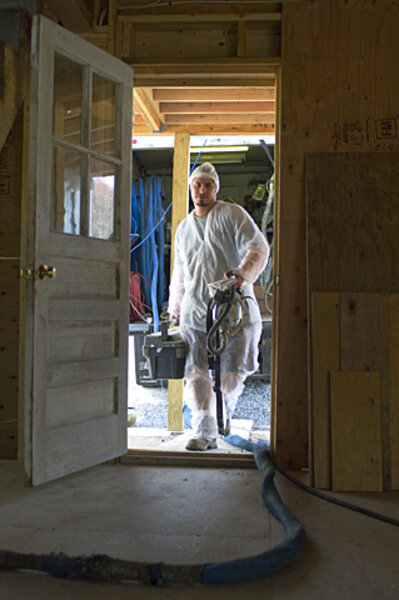The spacemen cometh: How spray-in insulation creates a leak-free building
Loading...
They appeared in a large white Anchor Insulation truck and are now turning our 1902 farmhouse into a 21st century insulation wonder. OK, so maybe I hyperbolize. But after writing more about insulation than I ever imagined possible, to actually see it in the process of being installed – white protective suit, facemask, hose, and spray-gun in hand – it is quite remarkable.
What they’re spraying is Icynene, an open-cell spray foam whose company touts it “creates continuously insulated, tight walls and ceilings,” what is essentially a “leak-free building envelope.” That’s exactly what drafty old Sheep Dog Hollow, our green renovation adventure, needs to move into its energy-efficient future.
Now, Icynene has its pros and cons. But I confess, I’ve found more pros than cons (although, since we opted to use it, I clearly am biased toward the pros).
On its upside, its made of organic materials. According to the product website Insulate For Life it “is a water-based formula that contains no formaldehyde, CFCs or HCFCs. The insulation has the texture and look of angel food cake and is made up of millions of tiny cells. These cells are filled with air and provide permanent control of air and airborne moisture movement. Icynene contains no materials that emit harmful gases.”
That explanation works for me (I particularly like the angel food cake reference). But it may not for the more technically minded, particularly since they probably already know that Icynene is developed in part from “products of the petrochemical industry similar in composition to many that are already in home use today.” But according to Foamco, an insulating contractor in upstate New York [http://www.foamcoinc.com/foamco-a-icynener-are-green.html], the manufacturer of the trademarked Icynene also has gone out of its way to use “castor oil to reduce reliance on petroleum-based polyol, offering a high-performance, eco-conscious option.” And for more on castor oil, go to insulationsmarts.com (.pdf). Here also is a link (.pdf) to Icynene’s product specifications.
The vast majority of comments I’ve found about Icynene are positive, but there are some complaints. At HowStuffWorks.com there was one user called Dan-in-Atlanta who complained the gassy smell after insulation has kept him out of his house for more than a month. It was a renovation like ours, but they had furniture and drapes around they believe absorbed the initial fumes from the installation. Dan-in-Atlanta recommends that any house in renovation that uses it should be well ventilated during installation. The company itself advises a minimum 24-hour wait after the installation for the house to be inhabited. Our neighbor down the road, who is also renovating an old home, used Icynene as well and had no such problems.
Other complaints at the Sprayfoam Forum had to do with adhesion problems and the potential for mold build-up if there’s, say, a leaky pipe. What impressed me, though, was the way certified Icynene dealers apparently dealt with problems: They owned up and fixed them. Melody-in-North Carolina had a problem with the spray foam not adhering properly to the studs: “We called the installer & they admitted to a ‘bad batch’ that day,” she wrote. “They will call back within a day or 2 to schedule another installation.”
I guess like so much else about renovation, your experience depends on the quality of the contractor doing the job, maybe even more than the product itself.
But let’s get back to the fun part. First, the house had to be prepared: which means cleaned up – swept off all the sawdust, scraps of wood, loose nails, and other construction detritus built up on the floor and in the stud cavities over the past several months. Then the Spacemen come, roll out plastic, pull in their hose, put on their masks and turn on their machine in their big white truck. Then, voilà, a thin layer of hot liquid is sprayed and adheres to the wall and expands to 60 times it’s size filling the studs with what appears to be a solid yellow cloud. (OK, OK, angel food cake-like – but that analogy is taken.) Then they shave the excess fluff and you have tightly sealed stud cavities – imagine a walnut shell filled with peanut butter after you’ve scraped off the excess with a knife.
Suddenly, that shell of a farmhouse we stumbled upon last July in a real estate office window is beginning to look and feel substantial – like a home somebody could actually live in... including Martin, me, and the girls (that would be Zoe the Pug and Mastan the Shepherd). Who ever believed it would be so?






